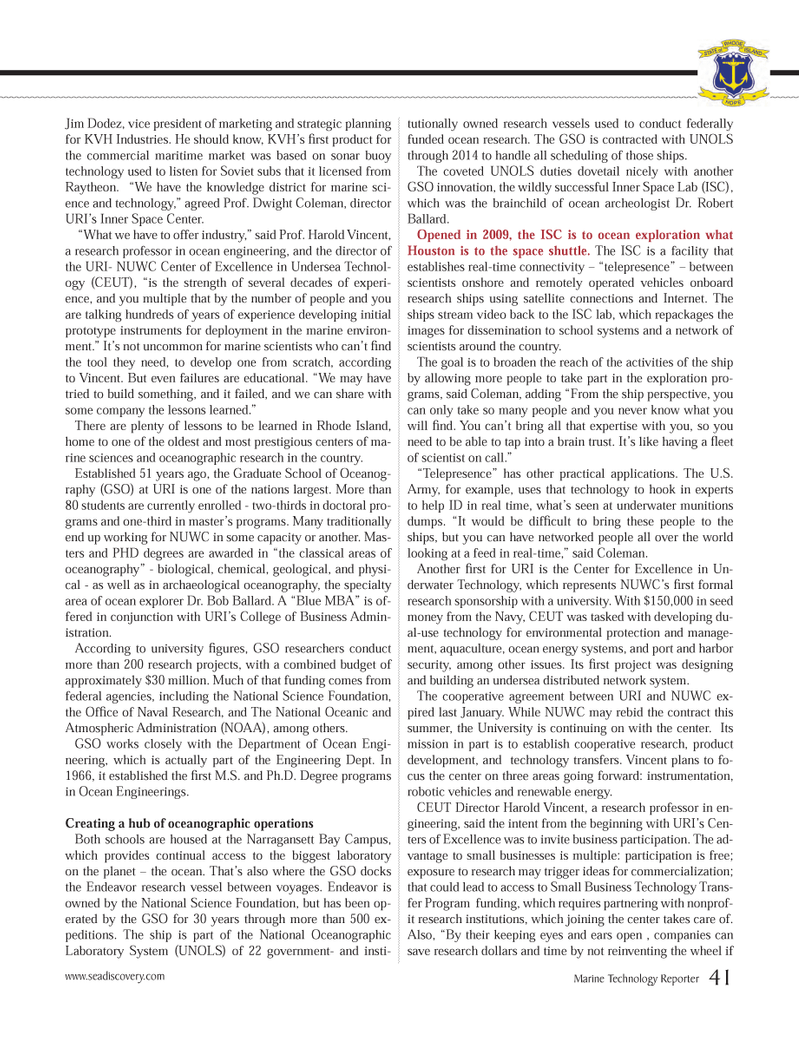
Page 41: of Marine Technology Magazine (March 2013)
Instrumentation: Measurement, Processing & Analysis
Read this page in Pdf, Flash or Html5 edition of March 2013 Marine Technology Magazine
Jim Dodez, vice president of marketing and strategic planning for KVH Industries. He should know, KVH?s rst product for the commercial maritime market was based on sonar buoy technology used to listen for Soviet subs that it licensed from Raytheon. ?We have the knowledge district for marine sci- ence and technology,? agreed Prof. Dwight Coleman, director URI?s Inner Space Center. ?What we have to offer industry,? said Prof. Harold Vincent, a research professor in ocean engineering, and the director of the URI- NUWC Center of Excellence in Undersea Technol- ogy (CEUT), ?is the strength of several decades of experi- ence, and you multiple that by the number of people and you are talking hundreds of years of experience developing initial prototype instruments for deployment in the marine environ- ment.? It?s not uncommon for marine scientists who can?t nd the tool they need, to develop one from scratch, according to Vincent. But even failures are educational. ?We may have tried to build something, and it failed, and we can share with some company the lessons learned.? There are plenty of lessons to be learned in Rhode Island, home to one of the oldest and most prestigious centers of ma-rine sciences and oceanographic research in the country. Established 51 years ago, the Graduate School of Oceanog-raphy (GSO) at URI is one of the nations largest. More than 80 students are currently enrolled - two-thirds in doctoral pro- grams and one-third in master?s programs. Many traditionally end up working for NUWC in some capacity or another. Mas- ters and PHD degrees are awarded in ?the classical areas of oceanography? - biological, chemical, geological, and physi-cal - as well as in archaeological oceanography, the specialty area of ocean explorer Dr. Bob Ballard. A ?Blue MBA? is of- fered in conjunction with URI?s College of Business Admin- istration. According to university gures, GSO researchers conduct more than 200 research projects, with a combined budget of approximately $30 million. Much of that funding comes from federal agencies, including the National Science Foundation, the Of ce of Naval Research, and The National Oceanic and Atmospheric Administration (NOAA), among others. GSO works closely with the Department of Ocean Engi- neering, which is actually part of the Engineering Dept. In 1966, it established the rst M.S. and Ph.D. Degree programs in Ocean Engineerings.Creating a hub of oceanographic operations Both schools are housed at the Narragansett Bay Campus, which provides continual access to the biggest laboratory on the planet ? the ocean. That?s also where the GSO docks the Endeavor research vessel between voyages. Endeavor is owned by the National Science Foundation, but has been op- erated by the GSO for 30 years through more than 500 ex- peditions. The ship is part of the National Oceanographic Laboratory System (UNOLS) of 22 government- and insti- tutionally owned research vessels used to conduct federally funded ocean research. The GSO is contracted with UNOLS through 2014 to handle all scheduling of those ships.The coveted UNOLS duties dovetail nicely with another GSO innovation, the wildly successful Inner Space Lab (ISC), which was the brainchild of ocean archeologist Dr. Robert Ballard.Opened in 2009, the ISC is to ocean exploration what Houston is to the space shuttle. The ISC is a facility that establishes real-time connectivity ? ?telepresence? ? between scientists onshore and remotely operated vehicles onboard research ships using satellite connections and Internet. The ships stream video back to the ISC lab, which repackages the images for dissemination to school systems and a network of scientists around the country. The goal is to broaden the reach of the activities of the ship by allowing more people to take part in the exploration pro- grams, said Coleman, adding ?From the ship perspective, you can only take so many people and you never know what you will nd. You can?t bring all that expertise with you, so you need to be able to tap into a brain trust. It?s like having a eet of scientist on call.? ?Telepresence? has other practical applications. The U.S. Army, for example, uses that technology to hook in experts to help ID in real time, what?s seen at underwater munitions dumps. ?It would be dif cult to bring these people to the ships, but you can have networked people all over the world looking at a feed in real-time,? said Coleman. Another rst for URI is the Center for Excellence in Un- derwater Technology, which represents NUWC?s rst formal research sponsorship with a university. With $150,000 in seed money from the Navy, CEUT was tasked with developing du- al-use technology for environmental protection and manage- ment, aquaculture, ocean energy systems, and port and harbor security, among other issues. Its rst project was designing and building an undersea distributed network system. The cooperative agreement between URI and NUWC ex- pired last January. While NUWC may rebid the contract this summer, the University is continuing on with the center. Its mission in part is to establish cooperative research, product development, and technology transfers. Vincent plans to fo- cus the center on three areas going forward: instrumentation, robotic vehicles and renewable energy. CEUT Director Harold Vincent, a research professor in en- gineering, said the intent from the beginning with URI?s Cen- ters of Excellence was to invite business participation. The ad- vantage to small businesses is multiple: participation is free; exposure to research may trigger ideas for commercialization; that could lead to access to Small Business Technology Trans- fer Program funding, which requires partnering with nonprof-it research institutions, which joining the center takes care of. Also, ?By their keeping eyes and ears open , companies can save research dollars and time by not reinventing the wheel if www.seadiscovery.com Marine Technology Reporter 41MTR #2 (34-49).indd 41MTR #2 (34-49).indd 413/6/2013 1:14:06 PM3/6/2013 1:14:06 PM

 40
40

 42
42
